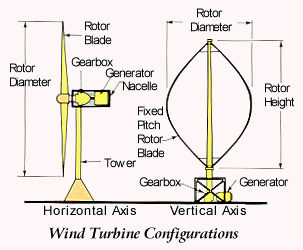vertical-axis wind turbine

A vertical-axis wind turbine (VAWT) is a type of wind turbine in which the axis of rotation is perpendicular to the wind stream and the ground. VAWTs work somewhat like a classical water wheel in which water arrives at a right angle (perpendicular) to the rotational axis (shaft) of the water wheel. Vertical-axis wind turbines fall into two major categories: Darrieus turbines and Savonius turbines. Neither type is in wide use today.
The basic theoretical advantages of a vertical axis machine are:
· The
generator, gearbox etc. may be placed on the ground, and a tower is not
essential for the machine to operate.
· A yaw mechanism isn't needed to turn the rotor against the wind
The basic disadvantages are:
· Wind speeds are very low close to ground level, so although a tower isn't essential, the wind speeds will be very low on the lower part of the rotor.
· The overall efficiency of the vertical axis machines is not impressive.
· The machine is not self-starting, i.e. a Darrieus machine needs a "push" before it will start. This is only a minor inconvenience for a grid-connected turbine, however, since the generator may be used as a motor drawing current from the grid to to start the machine.
· The machine may need guy wires to hold it up, but guy wires are impractical in heavily farmed areas.
· Replacing the main bearing for the rotor necessitates removing the rotor on both a horizontal and a vertical axis machine. In the case of the latter, it means tearing the whole machine down.
See also horizontal-axis wind turbine.
